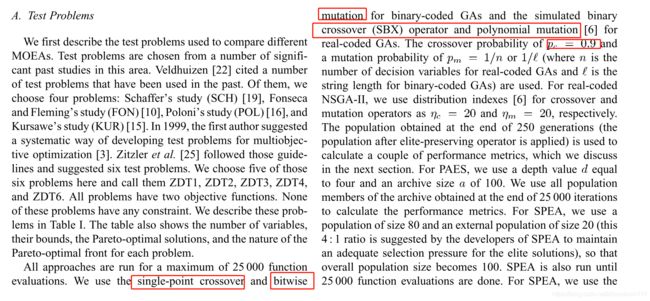多目标优化系列1---NSGA2的非支配排序函数的讲解
作为一名非数学、非计算机专业的野生研究僧程序员,在学习和实践多目标优化时,遇到了各种困难,加之相关方向的交流资源有限,也使得整个过程显得缓慢。在此,非常感谢西电晓风(https://blog.csdn.net/qq_40434430/article/details/82876572)及其他各路贡献知识的大神给予的启发、交流,他的严谨、谦虚、热情让我能不抛弃不放弃,入了门。
为何要专门讲解NSGA2非支配排序函数
多目标优化中的经典是NSGA2,NSGA2的经典是non-dominated sort。非支配排序做好了,才能谈后面的一切(这句话的领悟,非生而知之,而是在各种试错、奔溃的过程中领略到的)。掌握了NSGA2才能谈后面的其他各类算法,如:NSGA3,ε-NSGA2,MOEA,MOEA/D(这里的提法也并非完全正确,他们直接部分并没有强耦合关系,仅为个人一己之见)。
非支配排序函数的基本原理
需要说明几点潜在内涵:
- 都是求最小化问题(一个约定俗成的规则);
- 所有的 f i ( X a ) f_i(X_a) fi(Xa) 小于或者等于 f i ( X b ) f_i(X_b) fi(Xb) ,且至少存在一个 f i ( X a ) f_i(X_a) fi(Xa) 完全小于 f i ( X b ) f_i(X_b) fi(Xb)
- f i ( X a ) f_i(X_a) fi(Xa) 完全等于 f i ( X b ) f_i(X_b) fi(Xb)时, X a X_a Xa和 X b X_b Xb不存在支配关系(划重点:这个在实际的进化过程中,会出现很多,目前网上很多的代码忽略了这一点,会导致在已有Deb大神原始NSGA2测试问题上运行没问题,但是转换到现实问题中会出现很多的问题,如:不收敛、不稳定等。为什么会出现这样的问题呢?因为Deb大神采用的是标准遗传算子中的一种,即:实数编码和多项式交叉,且论文中定义的PC很大,世代之间出现完全复制的可能性小。然而,现实中应用改造问题,很多时候需要改造掉遗传算子,即:非标遗传算子,从而就会展现出各种奇葩问题。之所以在这里强调这问题,是因为我自己在这里耗费了很多的精力,各种调试,找不出原因,最终发现是因为一个等于号坑了我。也特别感谢课题组Jing Huang给予的耐心调试和讨论。)

如何测试非支配排序函数
我们需要构建专门针对非支配排序函数的测试类,从而验证函数的正确性,构建测试类的关键是在于输入的测试评价值Array的有效性。我通过大量的实验,提炼出基础的、正确的、报错的三个测试评价值Array。
- 基础的测试评价值Array,大家可以用来自行推演,该值参考至郑金华老师的书(主观评价:郑老师的书是目前国内对此块做了系统介绍的书,他的治学风格严谨、务实,而非论文的直接堆砌,建议入门学生可以从这本书开始,论文堆砌的书可以到高阶阶段再学习)
- 正确的测试评价值Array,跑ZDT3的时候从内存中Debug Copy的。
- 报错的测试评价值Array,跑ZDT6的时候从内存中Debug Copy的。以下给出的代码中test_fast_non_dominated_sort_error函数会显示出他错在哪。
import random
import numpy as np
from matplotlib.ticker import MultipleLocator
import matplotlib.pyplot as plt
class Test_class():
def __init__(self,f_num):
self.f_num=f_num
# 测试代码
Y1 = [9, 7, 5, 4, 3, 2, 1, 10, 8, 7, 5, 4, 3, 10, 9, 8, 7, 10, 9, 8]
Y2 = [1, 2, 4, 5, 6, 7, 9, 1, 5, 6, 7, 8, 9, 5, 6, 7, 9, 6, 7, 9]
self.objectives_fitness_zjh=np.array([Y1,Y2]).T
self.objectives_fitness_8 = np.array([[0.6373723585181119, 9.089424920752537],
[0.6307563745957109, 9.484134522661321],
[0.6307726564027054, 9.370453232401315],
[0.9214017573731662, 8.974173267351892],
[0.8106208092655269, 9.00814519794432],
[0.6308299859236132, 9.381311843663337],
[0.9996933421004693, 8.998732212375378],
[0.8106208092655269, 9.087298161567794],
[0.9968206553777186, 9.020037858133483],
[0.9503113437004427, 9.04519027298749],
[0.9214017573731662, 8.974173267351892],
[0.9214017573731662, 9.00187266065025],
[0.6307563745957109, 9.493829448943414],
[0.999999999999489, 9.180616877016963],
[0.8150090640161689, 9.041622216379706],
[0.9990805452551389, 8.980910429010232],
[0.9979468094812165, 9.04561922020985],
[0.7527617476769539, 9.136335451211739],
[0.6364241984468356, 9.20992553291975],
[0.8106208092655269, 9.083868693443087]])
self.objectives_fitness_20 = np.array([[0.01783689,1.02469787],
[0.04471213,0.93037726],
[0.0236877,0.96322404],
[0.04938809,0.92641409],
[0.07031985,0.83355839],
[0.05199109,0.88398541],
[0.05006115,0.91107188],
[0.,1.18579768],
[0.05358649,0.85849188],
[0.01657041,1.0721905,],
[0.10409921,0.84829613],
[0.06643826,0.84941993],
[0.05358649,0.89876683],
[0.01740193,1.09732744],
[0.04938809,0.94687415],
[0.05199109,0.93536007],
[0.02400905,1.11603965],
[0.05358649,0.89107165],
[0.,1.23996387],
[0.01783689,1.11625582]])
def test_fast_non_dominated_sort_1(self, objectives_fitness):
#对华电小扎扎写的非支配排序的修改和调整
# https: // blog.csdn.net / qq_36449201 / article / details / 81046586
fronts = [] # Pareto前沿面
fronts.append([])
set_sp = []
npp = np.zeros(2*10)
rank = np.zeros(2*10)
for i in range(2 * 10):
temp = []
for j in range(2 * 10):
if j != i:
if (objectives_fitness[j][0] >= objectives_fitness[i][0] and objectives_fitness[j][1] > objectives_fitness[i][1]) or \
(objectives_fitness[j][0] > objectives_fitness[i][0] and objectives_fitness[j][1] >= objectives_fitness[i][1]) or \
(objectives_fitness[j][0] >= objectives_fitness[i][0] and objectives_fitness[j][1] >= objectives_fitness[i][1]):
temp.append(j)
elif (objectives_fitness[i][0] >= objectives_fitness[j][0] and objectives_fitness[i][1] > objectives_fitness[j][1]) or \
(objectives_fitness[i][0] > objectives_fitness[j][0] and objectives_fitness[i][1] >= objectives_fitness[j][1]) or \
(objectives_fitness[j][0] > objectives_fitness[i][0] and objectives_fitness[j][1] > objectives_fitness[i][1]):
npp[i] += 1 # j支配 i,np+1
set_sp.append(temp) # i支配 j,将 j 加入 i 的支配解集里
if npp[i] == 0:
fronts[0].append(i) # 个体序号
rank[i] = 1 # Pareto前沿面 第一层级
i = 0
while len(fronts[i]) > 0:
temp = []
for j in range(len(fronts[i])):
a = 0
while a < len(set_sp[fronts[i][j]]):
npp[set_sp[fronts[i][j]][a]] -= 1
if npp[set_sp[fronts[i][j]][a]] == 0:
rank[set_sp[fronts[i][j]][a]] = i + 2 # 第二层级
temp.append(set_sp[fronts[i][j]][a])
a = a + 1
i = i + 1
fronts.append(temp)
del fronts[len(fronts) - 1]
self.output_fronts(fronts)
def output_fronts(self, fronts):
# test code
sum_coun = 0
for kk in range(len(fronts)):
sum_coun += len(fronts[kk])
print(sum_coun)
print(fronts)
def test_fast_non_dominated_sort_error(self, objectives_fitness):
#对华电小扎扎写的非支配排序的修改和调整
# https: // blog.csdn.net / qq_36449201 / article / details / 81046586
fronts = [] # Pareto前沿面
fronts.append([])
set_sp = []
npp = np.zeros(2*10)
rank = np.zeros(2*10)
for i in range(2 * 10):
temp = []
for j in range(2 * 10):
if j != i:
if (objectives_fitness[j][0] >= objectives_fitness[i][0] and objectives_fitness[j][1] >= objectives_fitness[i][1]) :
temp.append(j)
elif (objectives_fitness[i][0] > objectives_fitness[j][0] and objectives_fitness[i][1] > objectives_fitness[j][1]):
npp[i] += 1 # j支配 i,np+1
set_sp.append(temp) # i支配 j,将 j 加入 i 的支配解集里
if npp[i] == 0:
fronts[0].append(i) # 个体序号
rank[i] = 1 # Pareto前沿面 第一层级
i = 0
while len(fronts[i]) > 0:
temp = []
for j in range(len(fronts[i])):
a = 0
while a < len(set_sp[fronts[i][j]]):
npp[set_sp[fronts[i][j]][a]] -= 1
if npp[set_sp[fronts[i][j]][a]] == 0:
rank[set_sp[fronts[i][j]][a]] = i + 2 # 第二层级
temp.append(set_sp[fronts[i][j]][a])
a = a + 1
i = i + 1
fronts.append(temp)
del fronts[len(fronts) - 1]
self.output_fronts(fronts)
def output_fronts(self, fronts):
# test code
sum_coun = 0
for kk in range(len(fronts)):
sum_coun += len(fronts[kk])
print(sum_coun)
print(fronts)
def test_fast_non_dominated_sort_2(self, objectives_fitness):
#对Github Haris Ali Khan写的NSGA2的非支配排序函数的调整
# coding:utf-8
# Program Name: NSGA-II.py
# Description: This is a python implementation of Prof. Kalyanmoy Deb's popular NSGA-II algorithm
# Author: Haris Ali Khan
# Supervisor: Prof. Manoj Kumar Tiwari
set_sp=[[] for i in range(0, np.shape(objectives_fitness)[0])]
fronts = [[]]
npp=[0 for i in range(0, np.shape(objectives_fitness)[0])]
rank = [0 for i in range(0, np.shape(objectives_fitness)[0])]
for i in range(0, np.shape(objectives_fitness)[0]):
set_sp[i]=[]
# npp[i]=0
for j in range(0, np.shape(objectives_fitness)[0]):
if i != j:
if (objectives_fitness[j][0] >= objectives_fitness[i][0] and objectives_fitness[j][1] > objectives_fitness[i][1]) or \
(objectives_fitness[j][0] > objectives_fitness[i][0] and objectives_fitness[j][1] >= objectives_fitness[i][1]) or \
(objectives_fitness[j][0] >= objectives_fitness[i][0] and objectives_fitness[j][1] >= objectives_fitness[i][1]):
# 个体p的支配集合Sp计算
set_sp[i].append(j)
elif (objectives_fitness[i][0] >= objectives_fitness[j][0] and objectives_fitness[i][1] > objectives_fitness[j][1]) or \
(objectives_fitness[i][0] > objectives_fitness[j][0] and objectives_fitness[i][1] >= objectives_fitness[j][1]) or \
(objectives_fitness[j][0] > objectives_fitness[i][0] and objectives_fitness[j][1] > objectives_fitness[i][1]):
# 被支配度Np计算
# Np越大,则说明i个体越差
npp[i] += 1 # j支配 i,np+1
if npp[i]==0:
rank[i] = 0
if i not in fronts[0]:
fronts[0].append(i)
i = 0
while(fronts[i] != []):
Q=[]
for p in fronts[i]:
for q in set_sp[p]:
npp[q] =npp[q] - 1
if( npp[q]==0):
rank[q]=i+1
if q not in Q:
Q.append(q)
i = i+1
fronts.append(Q)
del fronts[len(fronts)-1]
self.output_fronts(fronts)
def test_fast_non_dominated_sort_3(self, objectives_fitness):
# 参考MoeaPlat的非支配排序
# https://blog.csdn.net/qq_40434430/article/details/82876572
fronts = [] # Pareto前沿面
fronts.append([])
set_sp = []
npp = np.zeros(2 * 10)
rank = np.zeros(2 * 10)
for i in range(2 * 10):
temp = []
for j in range(2 * 10):
if j != i:
less = 0 # y'的目标函数值小于个体的目标函数值数目
equal = 0 # y'的目标函数值等于个体的目标函数值数目
greater = 0 # y'的目标函数值大于个体的目标函数值数目
for k in range(self.f_num):
if (objectives_fitness[i][k] < objectives_fitness[j][k]):
less = less + 1
elif (objectives_fitness[i][k] == objectives_fitness[j][k]):
equal = equal + 1
else:
greater = greater + 1
if (less == 0 and equal != self.f_num):
npp[i] += 1 # j支配 i,np+1
elif (greater == 0 and equal != self.f_num):
temp.append(j)
set_sp.append(temp) # i支配 j,将 j 加入 i 的支配解集里
if npp[i] == 0:
fronts[0].append(i) # 个体序号
rank[i] = 1 # Pareto前沿面 第一层级
i = 0
while len(fronts[i]) > 0:
temp = []
for j in range(len(fronts[i])):
a = 0
while a < len(set_sp[fronts[i][j]]):
npp[set_sp[fronts[i][j]][a]] -= 1
if npp[set_sp[fronts[i][j]][a]] == 0:
rank[set_sp[fronts[i][j]][a]] = i + 2 # 第二层级
temp.append(set_sp[fronts[i][j]][a])
a = a + 1
i = i + 1
fronts.append(temp)
del fronts[len(fronts) - 1]
self.output_fronts(fronts)
if __name__ == '__main__':
test_class=Test_class(f_num=2)
# test zjh 普通
print("测试1:普通")
test_class.test_fast_non_dominated_sort_1(test_class.objectives_fitness_zjh)
test_class.test_fast_non_dominated_sort_2(test_class.objectives_fitness_zjh)
test_class.test_fast_non_dominated_sort_3(test_class.objectives_fitness_zjh)
test_class.test_fast_non_dominated_sort_error(test_class.objectives_fitness_zjh)
# test ZDT3 正确
print("测试2:正确,重点看错误的函数test_fast_non_dominated_sort_error")
test_class.test_fast_non_dominated_sort_1(test_class.objectives_fitness_20)
test_class.test_fast_non_dominated_sort_2(test_class.objectives_fitness_20)
test_class.test_fast_non_dominated_sort_3(test_class.objectives_fitness_20)
test_class.test_fast_non_dominated_sort_error(test_class.objectives_fitness_20)
# test ZDT6 错误
print("测试3:ZDT6 错误,重点看错误的函数test_fast_non_dominated_sort_error")
test_class.test_fast_non_dominated_sort_1(test_class.objectives_fitness_8)
test_class.test_fast_non_dominated_sort_2(test_class.objectives_fitness_8)
test_class.test_fast_non_dominated_sort_3(test_class.objectives_fitness_8)
test_class.test_fast_non_dominated_sort_error(test_class.objectives_fitness_8)
总结
这里写的测试函数,客观来说还是不够好的,因为是采用穷举的方式来验证小于、等于、大于的关系,两个目标函数的时候,这样写还是可以凑合的,但是如果是5个目标,这个显然就不可以了。所以增加了test_fast_non_dominated_sort_3()函数,正确的做法应该是参考mooplatm中,排除的写法,可以适用于多个目标,而不仅仅局限于两个目标。
